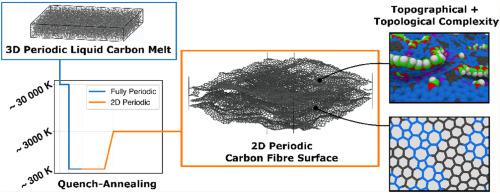Composites Science and Technology ( IF 8.3 ) Pub Date : 2021-09-23 , DOI: 10.1016/j.compscitech.2021.109049 F. Vuković 1 , T.R. Walsh 1

|
The atomic-scale surface structure of carbon fiber is not well resolved. This information would advance knowledge of structure-property relationships for carbon fiber in complex interfacial environments, e.g. composites. Molecular simulations could provide these insights, via incorporation of topological and topographical complexity into surface models of carbon fiber to explore this effect. This requires use of highly-specialized potentials. However, out of practicality, the majority of fiber interfacial simulations use multi-element, fixed-topology force-fields that are not harmonized with leading carbon-only potentials, resulting in the widespread adoption of graphite as a surrogate model of carbon fiber in interfacial simulations, neglecting complexity. To address this, a process for generating complex yet practical structural models of the carbon fiber surface is introduced. A carbon-only potential is used to generate topologically and topographically rich surfaces via annealing molecular dynamics simulations and manipulation of periodic boundary conditions. This produces fiber surfaces featuring edges, holes, convergent sheet boundaries, topological defects, amongst other structures. Key parameters of the process influence this complexity, ensuring structural tuneability of the resultant substrate. These structures are transposed into a multi-element molecular mechanics format. This approach provides practical structural models for immediate application in any interfacial simulation between carbon fiber and its complex environment.
中文翻译:

具有可调拓扑和形貌的碳纤维表面的实用原子模型
碳纤维的原子级表面结构没有得到很好的解析。该信息将促进碳纤维在复杂界面环境(例如复合材料)中的结构-性能关系的知识。分子模拟可以提供这些见解,通过将拓扑和地形复杂性结合到碳纤维的表面模型中来探索这种影响。这需要使用高度专业化的潜力。然而,出于实用性,大多数纤维界面模拟使用多元素、固定拓扑的力场,这些力场与主要的碳势不协调,导致广泛采用石墨作为界面中碳纤维的替代模型。模拟,忽略复杂性。为了解决这个问题,介绍了一种生成复杂而实用的碳纤维表面结构模型的过程。通过退火分子动力学模拟和周期性边界条件的操纵,仅碳势用于生成拓扑和地形丰富的表面。这会产生具有边缘、孔、会聚片边界、拓扑缺陷等结构的纤维表面。工艺的关键参数会影响这种复杂性,从而确保所得基板的结构可调性。这些结构被转换成多元素分子力学格式。这种方法提供了实用的结构模型,可立即应用于碳纤维与其复杂环境之间的任何界面模拟。通过退火分子动力学模拟和周期性边界条件的操纵,仅碳势用于生成拓扑和地形丰富的表面。这会产生具有边缘、孔、会聚片边界、拓扑缺陷等结构的纤维表面。工艺的关键参数会影响这种复杂性,从而确保所得基板的结构可调性。这些结构被转换成多元素分子力学格式。这种方法提供了实用的结构模型,可立即应用于碳纤维与其复杂环境之间的任何界面模拟。通过退火分子动力学模拟和周期性边界条件的操纵,仅碳势用于生成拓扑和地形丰富的表面。这会产生具有边缘、孔、会聚片边界、拓扑缺陷等结构的纤维表面。工艺的关键参数会影响这种复杂性,从而确保所得基板的结构可调性。这些结构被转换成多元素分子力学格式。这种方法提供了实用的结构模型,可立即应用于碳纤维与其复杂环境之间的任何界面模拟。孔、会聚片边界、拓扑缺陷等结构。工艺的关键参数会影响这种复杂性,从而确保所得基板的结构可调性。这些结构被转换成多元素分子力学格式。这种方法提供了实用的结构模型,可立即应用于碳纤维与其复杂环境之间的任何界面模拟。孔、会聚片边界、拓扑缺陷等结构。工艺的关键参数会影响这种复杂性,从而确保所得基板的结构可调性。这些结构被转换成多元素分子力学格式。这种方法提供了实用的结构模型,可立即应用于碳纤维与其复杂环境之间的任何界面模拟。









































 京公网安备 11010802027423号
京公网安备 11010802027423号